By John Leonard
Methoni Castle
With a long history as an ancient town, a Byzantine naval base, a nefarious pirate lair, a walled Venetian colony and commercial port, and an Ottoman fortress used to resist Greek independence, Methoni shares many similarities with Koroni. Together, these bustling castle-ports were “the two eyes of the Serenissima” (the Republic of Venice), securing and facilitating Venetian trade with the East. Fortified in the 1300s, the castle underwent numerous renovations through the centuries. Its Christian and Muslim residents repeatedly suffered raids, massacres, enslavement and other hardships. Today a tranquil, evocative ruin, the castle’s remains include a moat, towers, gateways, cobbled streets, a hamam, and the picturesque islet of Bourtzi.
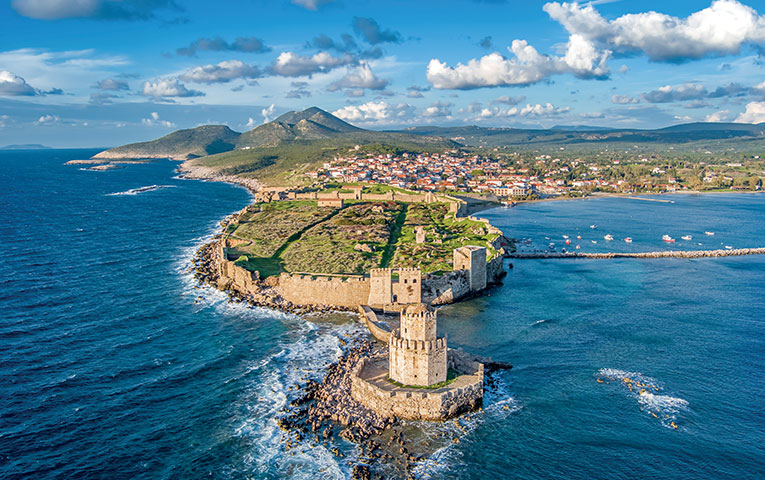
© NIKOS TSIAKALAKIS
The Mycenaean Tholos Tombs of Peristeria
The region of Messinia is filled with Late Bronze Age chamber or “tholos” tombs, the best examples of which can be seen only about an hour’s drive north of Costa Navarino at the Peristeria Archaeological Park, eight kilometers from Kyparissia. Also called “beehive” tombs, these were the final resting places of Mycenaean elites and their families, who were often buried with rich funerary gifts. At Peristeria, where three tholos tombs were excavated, discoveries have included gold and silver jewelry, finely carved scarab amulets, and bronze vases and swords. Comparable to Mycenae, Peristeria was long a center of regional power and wealth (1680–1180 BC).
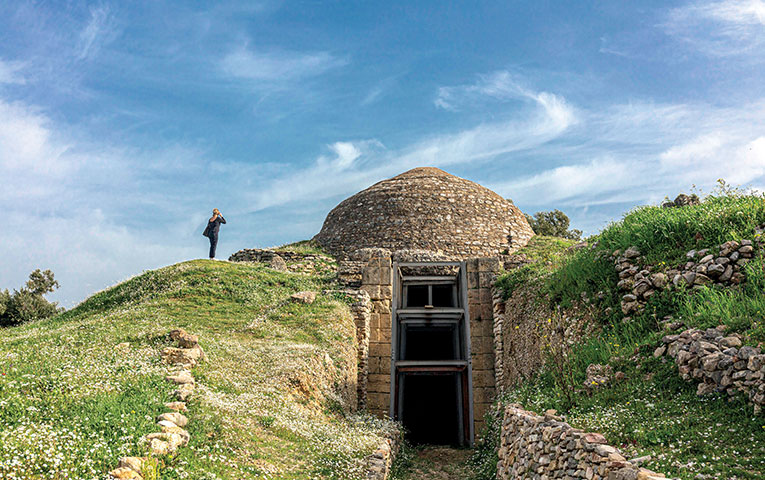
© PERIKLES MERAKOS
The Palace of Nestor (Ano Englianos)
The gem of prehistoric Messinia, the Palace of Nestor is particularly lustrous these days, with an impressive new roof protecting the site, improved story boards and paths, and two more tholos tombs now being investigated nearby. For lovers of Homer, this is the place; it’s where “King Nestor of sandy Pylos” resided, and where Telemachus, Odysseus’ son, came during his search for his long-lost father. Peaking in importance around 1300 BC, the hilltop site with its surrounding settlement became the region’s royal seat. The stunning contents of the newly unearthed Griffin Warrior tomb (circa 1450 BC) have revealed fascinating cultural ties between Mycenaean Pylos and Minoan Crete.
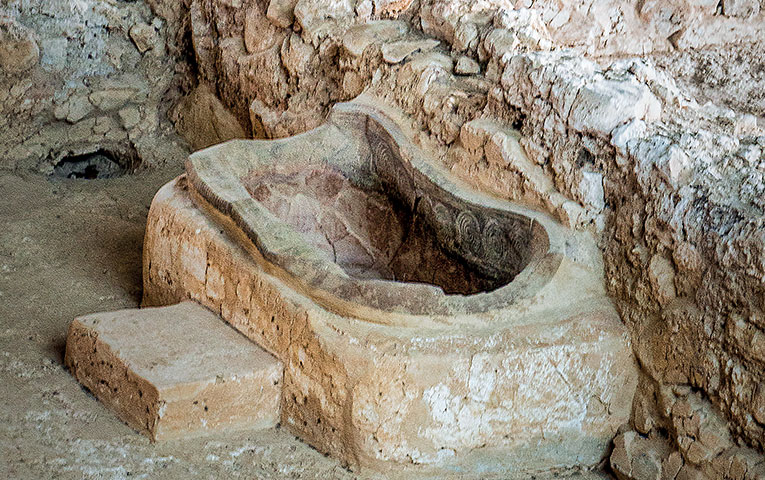
© PERIKLES MERAKOS – A ceramic bathtub discovered at Nestor’s Palace in Room 43, a bathing chamber located behind one of the royal apartments identified as the “Queen’s Hall.”
The Temple of Apollo Epicurius at Bassae (5th century BC)
One of the most iconic and intriguing ancient Greek monuments, the Temple of Apollo Epicurius (circa 420 BC), is also one of the most unusual; it is the only temple in Greece currently enshrouded by an enormous protective tent. Situated on a wild mountaintop in what is now NE Messinia, the temple, reportedly designed by Iktinos, a Parthenon architect, is Doric in style but also featured an Ionic inner colonnade and a Corinthian column in place of a cult statue. The exterior’s long-buried, ornately carved metopes were discovered by the Englishman Charles Cockerell in 1812, when he crawled down into a fox den.
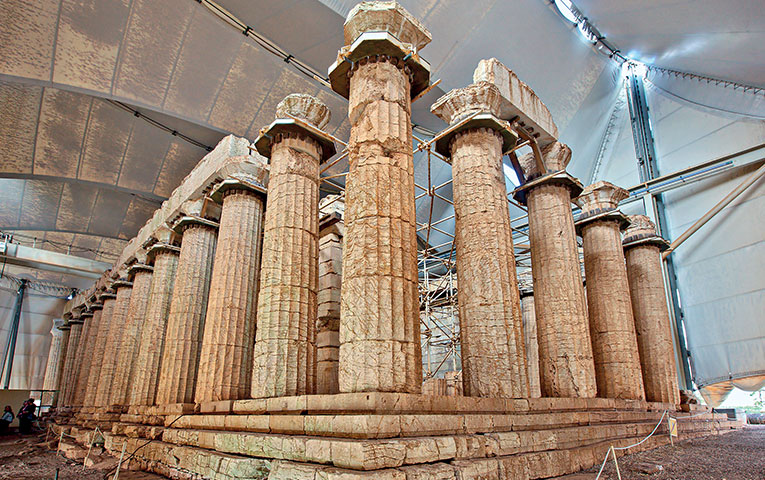
© SHUTTERSTOCK – Made from soft local limestone, not marble, the venerable ruins of the Apollo Epicurius temple are especially vulnerable to the elements and the passage of time.
Ancient Messene (4th century BC)
The walled Classical city of Messene, founded by the Theban general Epaminondas, marks a great turning point in the history of Messinia, as it was built for Sparta’s former subjects, the Messinian helots, after the Spartans were defeated at Leuctra by the Boeotians in 371 BC. No longer the unfettered power of the Peloponnese, Sparta now found itself penned in by its neighbors, while Messene continued to flourish through Hellenistic, Roman, and Byzantine times.
Now an extensive archaeological park, Messene offers its visitors a theater, an agora, numerous temples and small shrines, a sculpture-filled museum, and a stadium adorned with more than 150 re-erected columns.
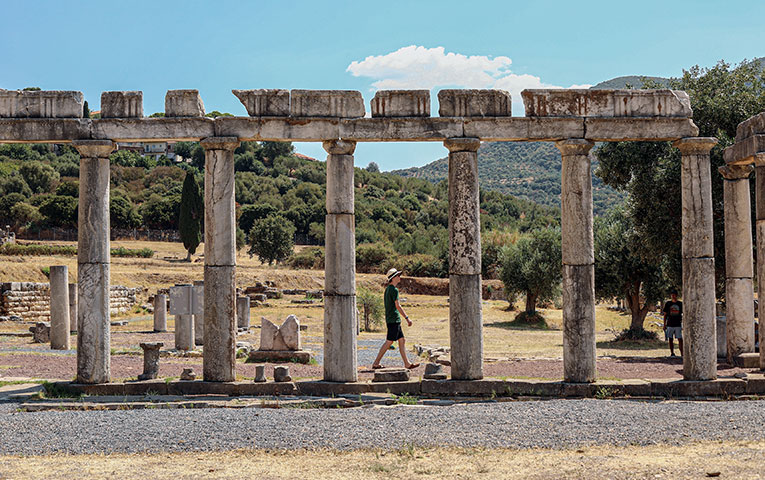
© GIANNIS LIAKOS / INTIME NEWS – In the shadow of Mt. Ithome, Messene’s massive, towered defensive walls once secured a city filled with lively public spaces, now inhabited once again by curious visitors.
The Monastery of Andromonastiro
A walled, towered monastic complex that might be mistaken for a fortress, the Monastery of Andromonastiro (“Men’s Monastery”), located only five kilometers southwest of ancient Messene, has a long and colorful history. Established in the late 12th century, it eventually served not only as a religious center (dedicated to the Transfiguration of Christ), but also as a place of refuge and resistance during the Greeks’ struggle for independence from the Ottoman Empire.
Damaged in 1770 during the Orlov Revolt, and again after 1825 by Ibrahim Pasha’s forces, the monastery has now been impressively restored. The catholicon (main church) contains wall paintings from the 13th and 17th–18th centuries.
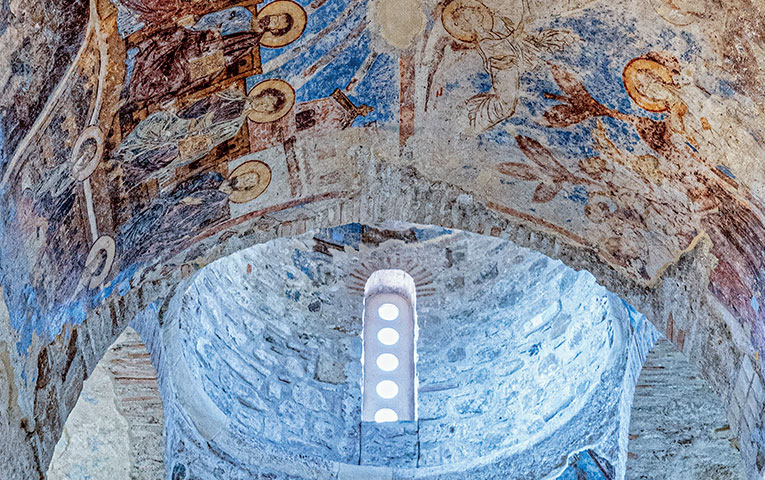
© PERIKLES MERAKOS – Interior of the catholicon at the Monastery of Andromonastiro, where haloed saints have long gazed down on the turbulent history of medieval and early modern Messinia.
Koroni Castle
Originally a Byzantine fortress (6th/7th century) installed on a strategic promontory overlooking the approach into the Messinian Gulf, Koroni Castle became a desirable military and commercial base. Although conquered by Frankish crusaders after the 1204 sack of Constantinople, it was soon wrested away by the Venetians, who vastly improved its aging fortifications (13th century).
With multiple bastions, towers, gates, churches, residences, tombs, and water cisterns, Koroni prospered as a Venetian colony, bishopric, and way station for pilgrims sailing to the Holy Land. Eventually lost to the Turks (1500), regained (1685), and lost again (1715), Koroni was at last freed in 1828 and consequently joined the modern Greek state.
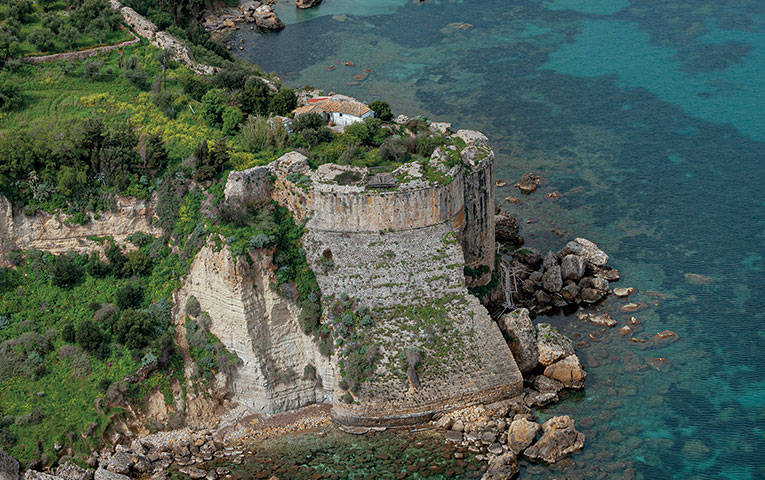
© GIANNIS GIANNELOS – The northeastern tower of Koroni Castle, once used for ammunition storage by the Nazi German army in WWII. Today, visitors can explore its picturesque ruins.
Sfaktiria Island
Enclosing the seaward side of the Bay of Navarino, flat-topped Sfaktiria Island has been a stage or backdrop for decisive battles that altered the course of Greek history. During the Peloponnesian War, the Athenians gained great momentum after trapping Sparta’s forces there (425 BC), later capturing and publicly parading 120 humiliated Spartan hoplites through Athens.
In 1825, the Greeks defending Pylos against Ibrahim Pasha’s repressive attacks were defeated on Sfaktiria, leading to their surrender of the fortress known as Neokastro. In 1827, the Ottoman-Egyptian fleet was decimated in the bay during the Battle of Navarino. Today, Sfaktiria’s visitors can see inscribed memorials as well as a Russian-built wooden chapel dating from 1897.
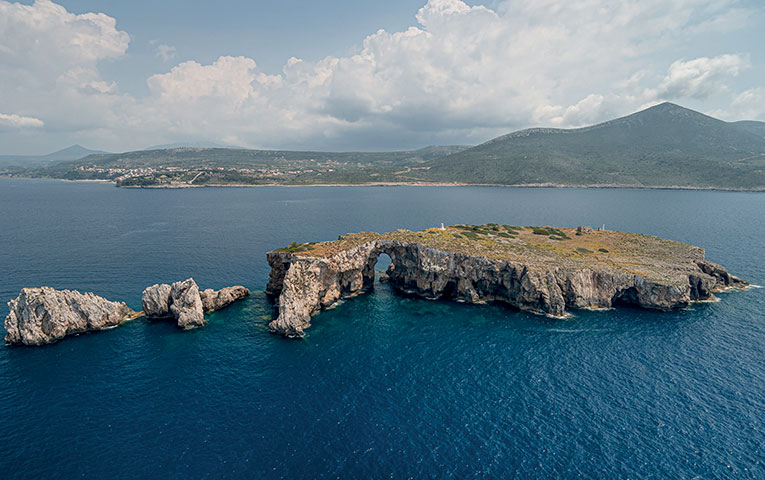
© GIANNIS GIANNELOS
Palaiokastro
At the north end of the Bay of Navarino stands Palaiokastro, a ruin high on the distinctive peak of Koryphasion. Erected in the 13th century by a Frankish lord of Thebes, Nicholas II of Saint-Omer, the castle continued a strategic tradition begun by the Athenians in 425 BC when they first fortified the site to control Pylos and its natural harbor.
Classical Pylos lay in this area; the modern town bearing that name was only established in 1830. Below Palaiokastro, the cavern known as Nestor’s Cave sheltered Neolithic inhabitants, while the Mycenaean “Tomb of Thrasymedes” points to the existence of a Bronze Age settlement beside the sandy, seaward-facing cove at Voidokilia.
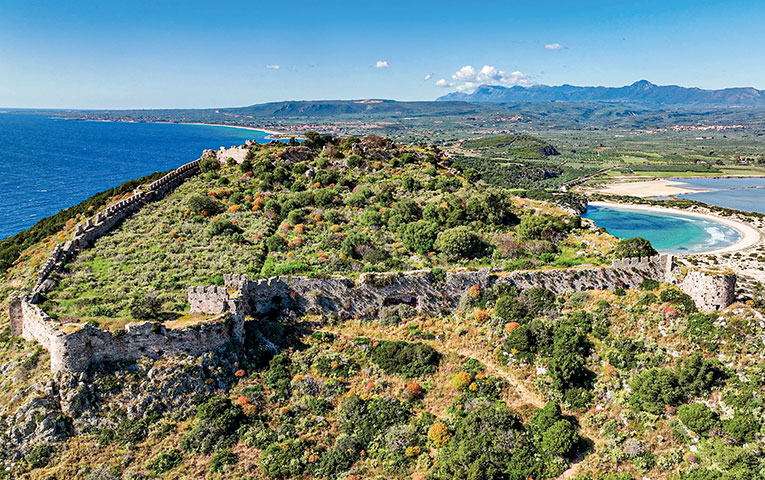
One of Messinia’s most intriguing and panoramic historical spots, the timeworn walls of Palaiokastro probably hold many stories as they stand majestically above the sea.
Neokastro
Nestled among pines on a hilltop overlooking present-day Pylos, the 16th-century fortress of Neokastro was built by the Ottomans to replace the crumbling Palaiokastro across the bay. With brief periods of occupation by the Venetians (1686–1715), Russians (1770), and revolutionary Greeks (1821–1825), Neokastro remained primarily in Turkish hands until being surrendered in 1828 to French troops supporting Greece.
Visitors today can enjoy pleasant refuge within the castle’s well-preserved walls. The former French barracks now accommodate the excellent Archaeological Museum of Pylos, while an exhibition dedicated to underwater archaeology presents local shipwreck discoveries. There’s also a former mosque, now restored as a church, and panoramic sea views.
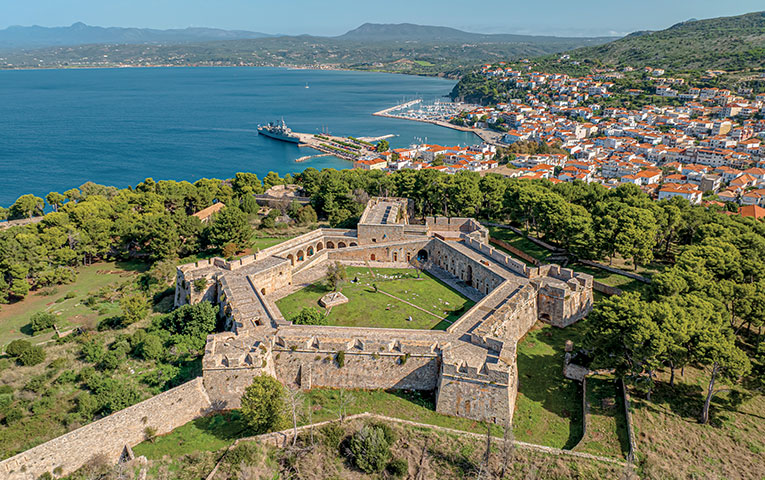
© NIKOS TSIAKALAKIS – The hexagonal upper citadel of Neokastro, a massive addition to the Ottoman castle by the Venetians, was defended with a dry moat and 60 powerful cannons.

